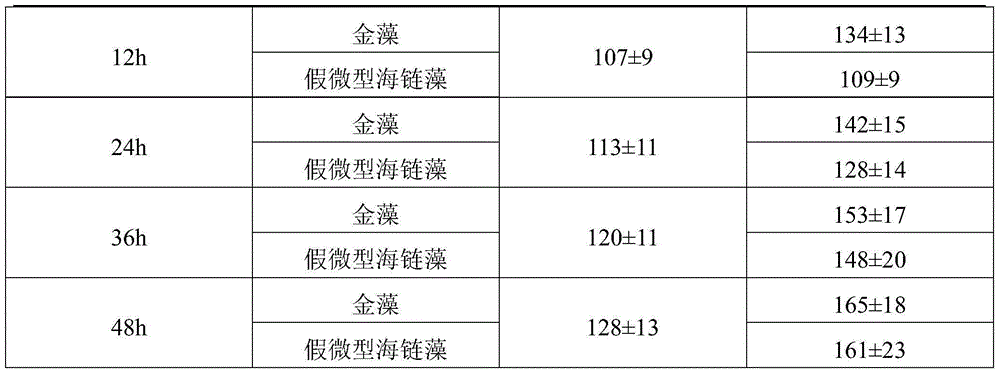Thalassiosira pseudonana and application of thalassiosira pseudonana as mercenaria mercenaria larva breeding bait
A technology of Thalassiosira pseudominiature and American clam, applied in the direction of application, microbe-based methods, microbes, etc., can solve the problems of slow reproduction speed and cannot meet the needs of rapid growth, and achieve the effect of improving stability
- Summary
- Abstract
- Description
- Claims
- Application Information
AI Technical Summary
Problems solved by technology
Method used
Image
Examples
Embodiment 1
[0014] Embodiment 1: Separation and purification of Thalassiosira pseudonana Guh005
[0015] The seawater samples taken from the prawn breeding pond in Shanyu Village, Wengyang Town, Yueqing City, Zhejiang Province in May 2010 were picked out with a capillary tube under an inverted microscope and cultured in a 96-well plate. The culture medium used It is an f / 2 medium (Guillard and Ryther 1962, Guillard 1975), the culture temperature is 25±1°C, the light-dark ratio is 12h:12h, and it is shaken twice a day at regular intervals. Under different light intensities (100-10000Lux), a strain of marine microalgae that can reproduce normally within the range of 2000-8000Lux in the light intensity - Thalassiosira pseudonana Guh005 strain was screened out, and was released on January 18, 2015 It is preserved in the Chinese Type Culture Collection Center located in Wuhan University, Wuhan, with the preservation number: CCTCC NO.M2015044. The algal strain screened by the present invention...
Embodiment 2
[0016] Embodiment 2: the expanded cultivation of Thalassiosira pseudonana Guh005
[0017] Thalassiosira pseudonana Guh005 algae species were inoculated into a 2500mL glass Erlenmeyer flask, which contained the culture medium used for primary culture, and the formula of the culture medium was 100mg KNO per liter of seawater 3 , 20mg KH 2 PO 4 , 10mg Na 2 SiO 3 , 0.20mg MnSO 4 ·H 2 O, 5.0mg FeSO 4 ·7H 2 O. 20mg EDTA-Na 2 , 6μg VB 1 and 0.05 μg VB 12 , the salinity of seawater is 20.5, but the salinity of seawater can vary in the range of 5-30. Shake the flask 3-6 times a day during culture, and culture in natural light at (20±2)°C for 1 week to reach a density of 5000cell·μL -1 Then put it into a 50L white plastic bucket and continuously inflate it with air for secondary culture (inoculation density 40-50cell·μL -1 ), the formula for secondary culture is 50 mg KNO per liter of seawater 3 , 15mg KH 2 PO 4 , 10mg Na 2 SiO 3 , 2.50mg FeSO 4 ·7H 2 O. 10mg EDTA-Na ...
Embodiment 3
[0022] Embodiment 3: Thalassiosira pseudonana is fed to young clam clams
[0023] The planktonic larvae of Clam americana were cultured in a cement pond of 8.5×3.5×1.2m (length×width×depth) continuously filled with air. When cultivating, natural seawater with a salinity of 25 is sand-filtered and put into the pool. At a culture temperature of 22-25°C, the clams lay eggs, fertilize and hatch, and the D-shaped larvae develop in 18h-22h. At this time, golden algae are fed to maintain the golden algae in the water. Density 5-8cell·μL -1About 36 hours later, start feeding Thalassiosira pseudonana, and feed twice a day. After the first feeding, the density of Thalassiosira pseudonana should be controlled at 30cell·μL -1 Afterwards, gradually increase the feeding amount every day with the development of American clams, and keep the algae density in the water body at 2-3cell·μL before each feeding. -1 Preferably, under the temperature condition of 22-25°C, it will attach and metamor...
PUM
 Login to View More
Login to View More Abstract
Description
Claims
Application Information
 Login to View More
Login to View More - R&D
- Intellectual Property
- Life Sciences
- Materials
- Tech Scout
- Unparalleled Data Quality
- Higher Quality Content
- 60% Fewer Hallucinations
Browse by: Latest US Patents, China's latest patents, Technical Efficacy Thesaurus, Application Domain, Technology Topic, Popular Technical Reports.
© 2025 PatSnap. All rights reserved.Legal|Privacy policy|Modern Slavery Act Transparency Statement|Sitemap|About US| Contact US: help@patsnap.com



